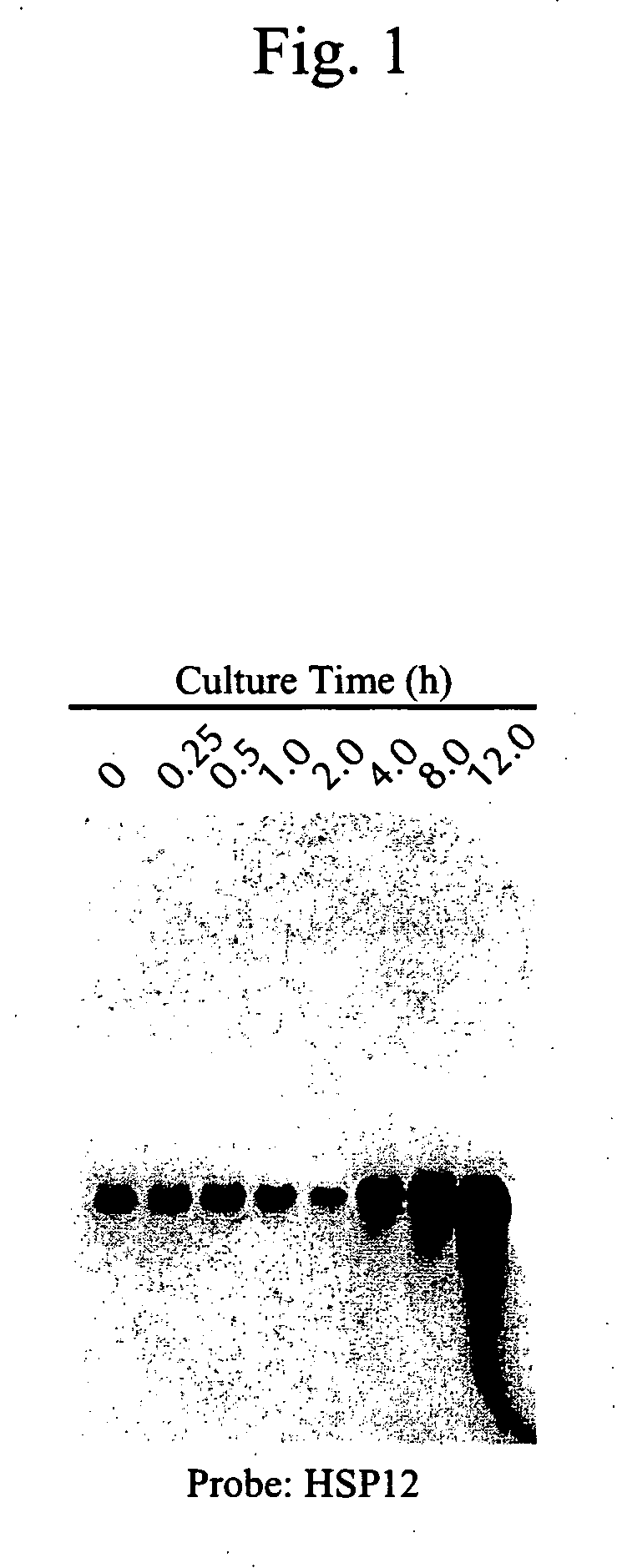Yeast-origin promoter and vector and expression system using the same
a promoter and vector technology, applied in the field of yeast-origin promoters and vectors, can solve the problems of inability to examine the degree of cold inducibility of each of the promoters of the above genes, limited amount of information regarding the functioning of yeast genes and disadvantageous culture at a low temperature in the production of proteins by genetic recombination
- Summary
- Abstract
- Description
- Claims
- Application Information
AI Technical Summary
Benefits of technology
Problems solved by technology
Method used
Image
Examples
example 1
Identification of Cold-Inducible Gene
[0084] A yeast strain, Saccharomyces cerevisiae YPH500 (purchased from Stratagene) was inoculated into 10 ml of YEPD medium (2% bactopeptone, 1% bactoyeast extract, 2% glucose), using an inoculating loop, followed by a shake culture at 30° C. for 2 days. 5 ml of the obtained culture solution was then inoculated into 1,000 ml of YEPD medium, followed by a shake culture at 30° C., until the absorbance at 600 nm became approximately 2 (Culture solution 1).
[0085] Fifty ml of a solution was separated from Culture solution 1, and cells were collected (a pre-low temperature treatment sample). The yeast cell mass was then frozen with liquid nitrogen, and the frozen cell mass was conserved at −80° C. in a deep freezer, until the time when RNA was prepared. The residue of Culture solution 1 was rapidly immersed in a shake water bath, which had previously been set at 10° C., and it was shaken for 30 minutes for quenching. Subsequently, the resultant produ...
example 2
Confirmation of Cold Inducibility of Cold-Inducible Gene
[0091] In order to confirm the cold inducibility of each cold-inducible gene identified by DNA microarray analysis, Northern blotting analysis was carried out according to the method described in Sambrook et al., Molecular Cloning, Cold Spring Harbor Laboratory. In order to measure the amount of RNA by Northern blotting analysis, probe DNA used to specifically detect RNA of interest was first prepared by the polymerase chain reaction (PCR) method. In the preset example, a method of producing the DNA probe of YFL014W (HSP12), one of the cold-inducible genes identified in Example 1, will be specifically described. Using the genome DNA of a Saccharomyces cerevisiae YPH500 strain, and an HSP12—F primer and an HSP12—R primer complementary to nucleotide sequences in the ORF of an HSP12 gene, and applying Expand High Fidelity PCR system (Roche), an HSP12 fragment consisting of approximately 330 bases was amplified with Takara PCR The...
example 3
Cold Induction of DNA Sequence Located Downstream by DNA Fragment Having Cold-Inducible Promoter Function
[0099] A DNA fragment having a cold-inducible promoter function was isolated, and heterogenous DNA was ligated downstream thereof, so that the production of RNA from DNA located downstream could be induced by a low temperature treatment. This was confirmed as follows. First, a DNA fragment having a DBP2 cold-inducible promoter function was isolated. The 5′ upstream adjacent gene of DBP2 is YNL113W (RPC19). A region sandwiched between RPC19 and DBP2 (that is, a non-translation region located upstream of the 5′-terminal side of DBP2) was isolated by PCR, using two primers, each consisting of 24 bases located downstream of the 3′-terminal side adjacent to the ORF of RPC19 (RPC19-DBP2 IGR F) and 28 bases located upstream of the 5′-terminal side adjacent to the ORF of DBP2 (RPC19-DBP2 IGR R), and the genome DNA of a Saccharomyces cerevisiae YPH500 strain.
[0100] The sequences of the ...
PUM
| Property | Measurement | Unit |
|---|---|---|
| culture temperature | aaaaa | aaaaa |
| temperature | aaaaa | aaaaa |
| temperature | aaaaa | aaaaa |
Abstract
Description
Claims
Application Information
 Login to View More
Login to View More - R&D
- Intellectual Property
- Life Sciences
- Materials
- Tech Scout
- Unparalleled Data Quality
- Higher Quality Content
- 60% Fewer Hallucinations
Browse by: Latest US Patents, China's latest patents, Technical Efficacy Thesaurus, Application Domain, Technology Topic, Popular Technical Reports.
© 2025 PatSnap. All rights reserved.Legal|Privacy policy|Modern Slavery Act Transparency Statement|Sitemap|About US| Contact US: help@patsnap.com



